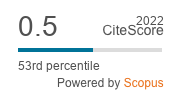The Contributions of Singular and Plural Nouns to Sentence Processing Complexity: Evidence from Reading Time
DOI:
https://doi.org/10.29038/eejpl.2020.7.1.mesKeywords:
reading, semantic representations, syntactic ambiguity, comprehension, plural nouns, singular nouns.Abstract
The nature of semantic representations of plural nouns has been a subject of debates in the literature. The present research investigated the extent to which there are differences in the processing of plural versus single noun descriptions (e.g., the large chairs vs. the large chair). In two reading experiments, we tested whether plural (versus singular) nouns appearing in sentences were more difficult to process initially and/or led to increased processing difficulty when occurring in sentences that contain a temporary syntactic ambiguity. Reading time on syntactically ambiguous sentences containing plural or singular nouns were compared with reading time on unambiguous control sentences. The results of both experiments demonstrated significant effects of sentence ambiguity. No effects or interactions involving noun number were observed, indicating that the complexity of plural nouns does not result in processing difficulty during sentence comprehension.
Downloads
References
Adams, B., Clifton, C., & Mitchell, D. (1998). Lexical guidance in sentence processing? Psychonomic Bulletin and Review, 5(2), 265–270. https://doi.org/10.3758/BF03212949
Baayen, R. H., Dijkstra, T., & Schreuder, R. (1997). Singulars and plurals in Dutch: Evidence for a parallel dual-route model. Journal of Memory and Language, 37(1), 94–117. https://doi.org/10.1006/jmla.1997.2509
Barker, C. (1992). Group terms in English: Representing groups as atoms. Journal of Semantics 9(1), 69–93. https://doi.org/10.1093/jos/9.1.69.
Barsalou, L. W. (1999). Perceptual symbol systems. Brain and Behavioral Sciences, 22, 577–660. https://doi.org/10.1017/S0140525X99002149.
Clark, H. H. (1973). The language-as-fixed-effect fallacy: A critique of language statistics in psychological research. Journal of Verbal Learning & Verbal Behavior, 12, 335–359. https://doi.org/10.1016/S0022-5371(73)80014-3
Dominguez, A., Cuetos, F., & Segui, J. (1999). The processing of grammatical gender and number in Spanish. Journal of Psycholinguistic Research, 28(5), 485–498. https://doi.org/10.1023/ A:1023216326448
Ferreira, F., & Henderson, J. (1990). Use of verb information during syntactic parsing: Evidence from eye tracking and word by word self-paced reading. Journal of Experimental Psychology: Learning, Memory, & Cognition, 16, 555–568. https://doi.org/10.1037/0278-7393.16.4.555
Ferreira, F., & Henderson, J. M. (1991). Recovery from misanalyses of garden-path sentences. Journal of Memory and Language, 30(6), 725–745. https://doi.org/10.1016/0749- 596X(91)90034-H.
Ferreira, F., & McClure, K. K. (1997). Parsing of garden-path sentences with reciprocal verbs. Language and Cognitive Processes, 12, 273–306. https://doi.org/10.1080/016909697386862
Garnsey, S. M., Pearlmutter, N. J., Myers, E., & Lotocky, M. (1997). The contributions of verb bias and plausibility to the comprehension of temporarily ambiguous sentences. Journal of Memory & Language, 37, 58–93. https://doi.org/10.1006/jmla.1997.2512
Johnson-Laird, P. (1983). Mental Models: Towards a Cognitive Science of Language, Inference, and Consciousness. Cambridge, MA: Harvard University Press.
Kennison, S. M. (2001). Limitations on the use of verb information in sentence comprehension. Psychonomic Bulletin & Review, 8, 132–138. https://doi.org/10.3758/BF03196149
Kennison, S. M. (2005). Different time courses of integrative semantic processing for plural and singular nouns: Implications for theories of sentence processing. Cognition, 97, 269–294. https://doi.org/10.1016/j.cognition.2004.09.005
Mitchell, D. C. (1987). Lexical guidance in human parsing: Locus and processing characteristics. In M. Coltheart (Ed.), Attention and Performance 12: The Psychology of Reading (pp. 601–618). Hillsdale, NJ, England: Lawrence Erlbaum Associates, Inc.
New, B., Brysbaert, M., Segui, J., Ferrand, L., & Rastle, K. (2004). The processing of singular and plural nouns in French and English. Journal of Memory and Language, 51, 568–585. https://doi.org/10.1016/j.jml.2004.06.010
Patson, N. D. (2014). The processing of plural expressions. Language and Linguistics Compass, 8(8), 319–329. http://dx.doi.org/10.1111/lnc3.12085
Patson, N. D., George, G., & Warren, T. (2014). The conceptual representation of number. The Quarterly Journal of Experimental Psychology, 67(7), 1349–1365. http://dx.doi.org/10.1080/17470218.2013.863372
Patson, N.(2014). The processing of plural expressions. Language and Linguistics Compass, 8(8), 319–329. http://dx.doi.org/10.1111/lnc3.12085
Patson, N. (2016). Evidence in support of a scalar implicature account of plurality. Journal of Experimental Psychology: Learning, Memory, and Cognition, 42(7), 1140–1153. https://doi.org/10.1037/xlm0000224
Patson, N. D., & Ferreira, F. (2009). Conceptual plural information is used to guide early parsing decisions: Evidence from garden-path sentences with reciprocal verbs. Journal of Memory and Language, 60, 464–486.
Patson, N., George, G., & Warren, T. (2014). The conceptual representation of number. The Quarterly Journal of Experimental Psychology, 67(7), 1349–1365. http://dx.doi.org/10.1080/17470218.2013.863372
Patson, N., & Warren, T. (2011). Building complex reference objects from dual sets. Journal of Memory and Language, 64, 443–459. https://doi.org/10.1080/17470218.2013.863372
Patson, N., & Warren, T. (2014). Comparing the roles of referents and event structures in parsing preferences. Language, Cognition and Neuroscience, 29, 408–423. http://dx.doi.org/10.1080/01690965.2013.788197
Schneider, W., Eschman, A., & Zuccolotto, A. (2002). E-Prime (Version 2.0). [Computer software and manual]. Pittsburgh, PA: Psychology Software Tools Inc.
Schreuder, R., & Baayen, R. (1997). How complex simple words can be. Journal of Memory and Language, 37(1), 118–139. https://doi.org/10.1006/jmla.1997.2510
Schwarzschild, R. (1996). Pluralities. Kluwer, Dordrecht.
Sereno, J. A., & Jongman, A. (1997). Processing of English inflectional morphology. Memory &
Cognition, 25(4), 425–437. https://doi.org/10.3758/BF03201119
Sturt, P., Pickering, M. J., & Crocker, M. W. (2000). Search strategies in syntactic reanalysis. Journal
of Psycholinguistic Research, 29(2), 183–194. https://doi.org/10.1023/A:1005145028351 Zwaan, R. A., Stanfield, R. A., & Yaxley, R. H. (2002). Language comprehenders mentally represent the shapes of objects. Psychological science, 13(2), 168–171. https://doi.org/10.1111/1467-
00430
Downloads
Published
Issue
Section
License
Copyright (c) 2020 East European Journal of Psycholinguistics. 2014 - 2020. All Rights Reserved.

This work is licensed under a Creative Commons Attribution 4.0 International License.











 Creative Commons «Attribution» 4.0
Creative Commons «Attribution» 4.0